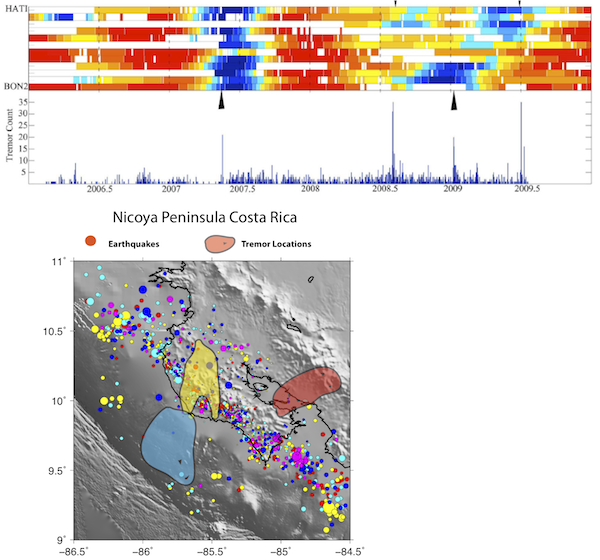2012 IRIS Workshop
Slow Slip and Tremor at the Northern Costa Rica Subduction Zone
Susan Y. Schwartz: Jake Walter: UC Santa Cruz; Marino Protti:, Victor Gonzalez: OVSICORI-UNA, Costa Rica; Andrew Newman:Georgia Institute of Technology
Top: GPS derived positioning-rate-gram from Jiang et al. [2012] and tremor activity at the Nicoya Peninsula [Walter et al., 2011]. Arrows mark slow slip events in May 2007, August 2008, January 2009 and June 2009. Bottom: Map showing the approximate regions where tremor episodes and normal earthquakes locate.

Full-resolution graphics file in original format: 0087.ai
The discovery of slow slip and tremor has fundamentally changed our notions of how strain is released at plate boundaries and with it our assessment of their seismic hazards. While the last decade has witnessed an explosion in slow slip and tremor research, there are still some very important issues that remain unresolved. Whether tremor always accompanies slow slip and whether the occurrence of tremor always implies slow slip, if slow slip and tremor are mostly restricted to the down-dip edge of the seismogenic zone or commonly occur at the up-dip edge or at other locations on the plate interface are still not well established. Investigations of slow slip and tremor at a number of subduction zones with different thermal and mechanical properties is helping to address these issues. Observations of slow slip and tremor at the Nicoya Peninsula in northern Costa Rica are of particular interest due to the contrast in thermal structure and heterogeneous locking in the seismogenic zone compared with the best studied SW Japan and Cascadia margins. The temporal and spatial distribution of more than 6 years of slow slip and tremor at the Nicoya Peninsula, Costa Rica reveals that some degree of slow slip occurs perpetually, both at the edges and within the seismogenic zone, rather than only at the down-dip edge as reported in most other environments. Tremor locations are anti-correlated with normal earthquakes providing support to the contention that they represent unique frictional properties. If the occurrence of slow slip and tremor requires a transition in frictional properties from velocity weakening to strengthening, then tremor locations may be used to indicate where these frictional transitions occur within the seismogenic zone and thus the likely locations of maximum slip in future earthquakes.
Acknoweldgements: This research was supported by NSF grants OCE-0841061 and EAR-0842338 to SYS. GPS figure comes from: Jiang Y., S. Wdowinski,T.H Dixon, M. Hackl, M. Protti, V. Gonzalex, 2012. Slow slip events in Costa Rica detected by continuous GPS observations, 2002-2011, Geochem, Geophys., Geosys., 13(1), Q04006.
For further reading: Walter, J.I., S.Y. Schwartz, M. Protti, V. Gonzalez, 2011. Persistent tremor within the northern Costa Rica seismogenic zone, Geophys. Res. Lett., 38(1), L01307. doi: 10.1029/2010GL045586
Keywords: slow_slip, nonvolcanic_tremor
